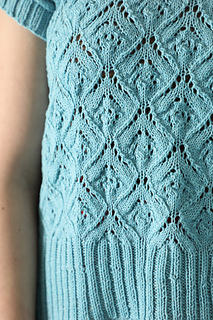patterns >  knitscene, The Summer Solstice Collection
knitscene, The Summer Solstice Collection
> Dewdrops Tee





Dewdrops Tee
Get the full collection for $14.99.
The Dewdrops Tee presents a modern take on a classic shape. The back and front of this charming top are worked separately from the top down to the underarm, then the pieces are joined in the round and the lower body is worked circularly to the ribbed hem. The body is worked in an allover lace pattern to the lower ribbing, which is finished with short-rows to create the asymmetrical hem.
Difficulty Intermediate
Yarn Weight 1
Finished Size 40 (43, 46 ¼, 49 ¼, 52 ¼, 55 ½, 61 ½, 64 ½)“ circumference at underarm. Pullover shown measures 43”; modeled with 7” of positive ease.
Yarn Amano Yarns Chaski (60% superwash Merino wool, 30% Pima cotton, 10% linen; 383 yd 350 m/ 3 ½ oz 100 g): #1710 Brook, 3 (3, 4, 4, 4, 5, 5, 5) skeins. Yarn distributed by Berroco.
Needles Sizes 3 (3.25 mm) and 4 (3.5 mm): 32” circular (cir). Size 3 (3.25 mm): 16” cir. Adjust needle size if necessary to obtain the correct gauge.
Notions Marker (m); stitch holder; tapestry needle.
Gauge 26 sts and 35 rnds = 4” in lace patt on larger needle.
For techniques you don’t know, please visit our online knitting glossary.
NOTES
-
This top is worked back and forth in separate pieces from the top down to the underarm, then the front and back are joined and the body is worked in the round to the ribbed lower edge. After working the ribbing for 1 1/4”, the body is divided for the front and back and worked separately back and forth with short-row shaping to create the angled edge.
-
For some sizes, at the beginning and/or end of Rows 5 and 17 of the charts, there is a single decrease rather than a double decrease (because there are not enough stitches for two yarnovers). When working in the round, work a double decrease as shown in the repeated section of the charts.
678 projects
stashed
590 times
- First published: May 2021
- Page created: May 13, 2021
- Last updated: August 11, 2022 …
- visits in the last 24 hours
- visitors right now




